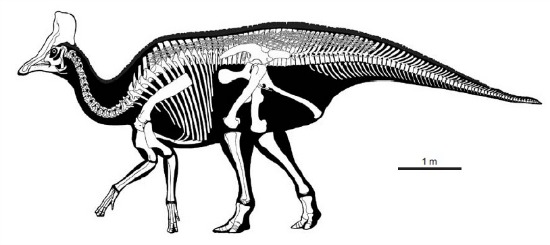Outlining Olorotitan
A new study reexamines the skeleton of Olorotitan, a lovely hadrosaur from Russia
![]()
Olorotitan was one of the most elegant dinosaurs of all time. The 26-foot-long hadrosaur, found in the Late Cretaceous rocks of eastern Russia, had the typical deep tail, beefy legs and slender arms of its kin, but a fan-shaped crest jutting out of the back of the dinosaur’s skull gave it a striking profile. As with its North American cousins Corythosaurus and Lambeosaurus, the hollow head ornament is what makes this dinosaur stand out.
Paleontologist Pascal Godefroit of the Royal Belgian Institute of Natural Sciences and colleagues initially described Olorotitan in 2003. Now, in Acta Palaeontologica Polonica, Godefroit joins co-authors Yuri Bolotsky of the Russian Academy of Sciences and Ivan Bolotsky of Jilin University in China in a thorough assessment of the hadrosaur’s osteology and relationships. The study is based on a mostly complete skull and skeleton–the dinosaur is primarily missing its hands and feet, perhaps because scavengers consumed them before the Olorotitan was buried, but much of the rest of the skeleton was found in articulation.
The hadrosaur’s crest is the most distinct part of its skeleton. As the researchers write, “The large crest dominates the skull.” While crushed and not entirely complete, the preserved part of the crest nevertheless shows that the ornament curved up high over the skull. According to the paper’s reconstruction of the missing skull parts, the front spire of the crest supported a backwards-pointing fan of bone.
This crest was hollow, just as in North American lambeosaurine hadrosaurs such as Parasaurolophus. Indeed, these ornaments were not just for show, but probably allowed adorned dinosaurs to allow them to bellow low-frequency calls over long distances. Each species had their own call based on the shape of the nasal passage inside their skull. Frustratingly, though, the relevant portions of the crest in the Olorotitan skull are either fragmentary or crushed, so no one knows the route its nasal passage took. We need another skull to find out.
There are a few other curious things about Olorotitan. The dinosaur’s skeleton has 18 neck vertebrae–several more than other hadrosaurs. While certainly not in the sauropod class of magnificent necks, Olorotitan had a relatively elongated neck compared with its closest relatives, which is fitting for a creature’s whose name translates to “gigantic swan.”
Further along the spine, the dinosaur’s skeleton seemed to have 15 sacral vertebrae (the fused vertebrae that run through the upper blades of the hips). But, as Godefroit and collaborators point out, the actual number of sacral vertebrae is probably slightly lower. The principal, mostly-complete Olorotitan skeleton used in the study was apparently an old individual in which extra bones of the lower back and tail fused to those at the sacrum.
But, in comparison with another specimen, the estimated age of the mostly-complete Olorotitan shows how size can be a deceiving factor in determining how old a dinosaur was. Godefroit and colleagues point out that various aspects of the old animal’s skeleton were fused, and that the dinosaur shows evidence of many repaired fractures. But there’s another partial Olorotitan skeleton–principally a portion of the lower back, hip and part of the tail–that appears to be of “equivalent size” that doesn’t show these age-related characteristics. If this is accurate, it’s a reminder that dinosaurs varied in terms of size at any particular age–just like us. That’s a simple fact, but something worth keeping in mind as researchers continue to debate how dinosaurs grew up. Skeletal indicators of age, such as bone fusion and the microstructure of skeletal elements, are more important than size alone.
Reference:
Godefroit, P., Bolotsky, Y., Alifanov, V. (2003). A remarkable hollow-crested hadrosaur from Russia: an Asian origin for lambeosaurines Comptes Rendus Palevol, 2, 143-151 DOI: 10.1016/S1631-0683(03)00017-4
Godefroit, P., Bolotsky, Y.L., and Bolotsky, I.Y. (2012). Olorotitan arharensis, a hollow-crested hadrosaurid dinosaur from the latest Cretaceous of Far Eastern Russia. Acta Palaeontologica Polonica DOI: 10.4202/app.2011.0051
/https://tf-cmsv2-smithsonianmag-media.s3.amazonaws.com/accounts/headshot/RileyBlack.png)

/https://tf-cmsv2-smithsonianmag-media.s3.amazonaws.com/accounts/headshot/RileyBlack.png)